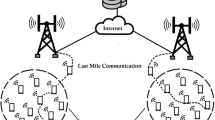Abstract
It has been proved theoretically that a network with heterogeneous congestion control algorithms that react to different congestion signals can have multiple equilibrium points. In this paper, we demonstrate this experimentally using TCP Reno and Vegas/FAST. We also show that any desired inter-protocol fairness is in principle achievable by an appropriate choice of Vegas/FAST parameter, and that intra-protocol fairness among flows within each protocol is unaffected by the presence of the other protocol except for a reduction in effective link capacities. Dummynet experiments and ns-2 simulations are presented to verify these results.
Similar content being viewed by others
References
A. Akella, S. Seshan and A. Shaikh, An empirical evaluation of wide-area internet bottlenecks, In Proceedings of ACM SIGMETRICS (2003) pp. 316–317.
C. Casetti, M. Gerla, S. Mascolo, M. Sansadidi and R. Wang, TCP Westwood: end to end congestion control for wired/wireless networks, Wireless Networks Journal 8 (2002) 467–479.
S. Floyd, Highspeed TCP for large congestion windows. RFC 3649, IETF Experimental. (2003) http://www.faqs.org/rfcs/rfc3649.html.
L.A. Grieco and S. Mascolo, Performance evaluation and comparison of westwood+, new reno, and vegas tcp congestion control. SIGCOMM Comput. Commun. Rev. 34(2) (2004) 25–38.
C. Hollot, V. Misra and W. Gong, Analysis and design of controllers for AQM routers supporting TCP flows, IEEE Transactions on Automatic Control 47(6) (2002).
C. Jin, D.X. Wei, and S.H. Low, FAST TCP: motivation, architecture, algorithms, performance. in Proceedings of IEEE Infocom. (2004) http://netlab.caltech.edu.
F.P. Kelly, A. Maulloo and D. Tan, Rate control for communication networks: Shadow prices, proportional fairness and stability, Journal of Operations Research Society 49(3) (1998) 237–252.
T. Kelly, Scalable TCP: Improving performance in highspeed wide area networks, ACM SIGCOMM Computer Communication Review 33(2) (2003) 83–91.
S. Kunniyur and R. Srikant, End-to-end congestion control: Utility functions, random losses and ECN marks. IEEE/ACM Transactions on Networking 11(5) (2003) 689–702.
K. Kurata, G. Hasegawa and M. Murata, Fairness comparisons between TCP Reno and TCP Vegas for future deployment of TCP Vegas. In Proceedings of INET (2000).
S.H. Low, A duality model of TCP and queue management algorithms, IEEE/ACM Transactions on Networking 11(4) (2003) 525–536. http://netlab.caltech.edu.
S.H. Low and D.E. Lapsley, Optimization flow control I: Basic algorithm and convergence. IEEE/ACM Transactions on Networking 7(6) (1999) 861–874.
S.H. Low, F. Paganini, J. Wang and J.C. Doyle, Linear stability of TCP/RED and a scalable control. Computer Networks Journal 43(5) (2003) 633–647. http://netlab.caltech.edu.
S.H. Low, L. Peterson and L. Wang, Understanding Vegas: A duality model. Journal of ACM 49(2) (2002) 207–235. http://netlab.caltech.edu.
L. Massoulie and J. Roberts, Bandwidth sharing: Objectives and algorithms. IEEE/ACM Transactions on Networking 10(3) (2002) 320–328.
J. Mo, R. La, V. Anantharam and J. Walrand, Analysis and comparison of TCP Reno and Vegas. In Proceedings of IEEE Infocom (1999).
J. Mo and J. Walrand, Fair end-to-end window-based congestion control. IEEE/ACM Transactions on Networking 8(5) (2000) 556–567.
L. Rizzo, IP dummynet. http://info.iet.unipi.it/~luigi/ip_dummynet/.
A. Shriram and J. Kaur, Identifying bottleneck links using distributed end-to-end available bandwidth measurements. In First ISMA Bandwidth Estimation Workshop (2003).
A. Tang, J. Wang, S.H. Low and M. Chiang, Equilibrium of heterogeneous congestion control protocols. Technical Report CaltechCSTR:2005.005, Caltech (2005a).
A. Tang, J. Wang, S.H. Low and M. Chiang, Network equilibrium of heterogeneous congestion control protocols. In Proceedings of IEEE Infocom Miami, FL (2005b).
D.X. Wei, C. Jin, S.H. Low and S. Hedge, FAST TCP: motivation, architecture, algorithms, performance. To appear in IEEE/ACM Trans. on Networking.
L. Xu, K. Harfoush and I. Rhee, Binary increase congestion control for fast long-distance networks. In Proceedings of IEEE Infocom (2004).
H. Yaiche, R.R. Mazumdar and C. Rosenberg, A game theoretic framework for bandwidth allocation and pricing in broadband networks. IEEE/ACM Transactions on Networking 8(5) (2000) 667–678.
Author information
Authors and Affiliations
Corresponding author
Rights and permissions
About this article
Cite this article
Tang, A., Wang, J., Hegde, S. et al. Equilibrium and Fairness of Networks Shared by TCP Reno and Vegas/FAST. Telecommun Syst 30, 417–439 (2005). https://doi.org/10.1007/s11235-005-5499-1
Issue Date:
DOI: https://doi.org/10.1007/s11235-005-5499-1




